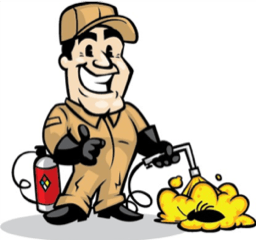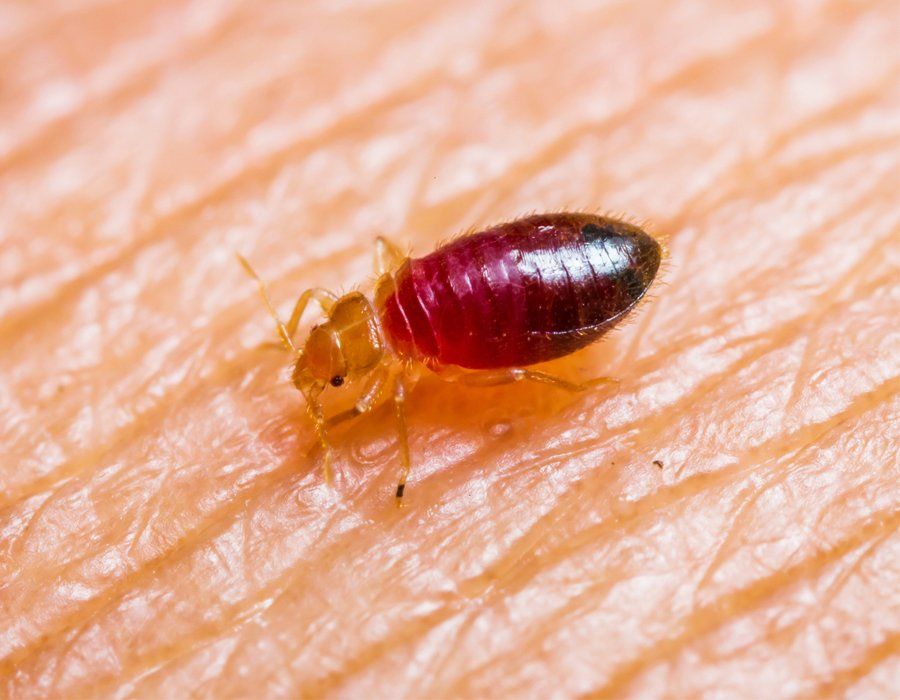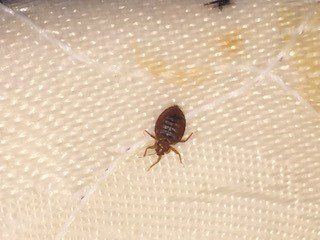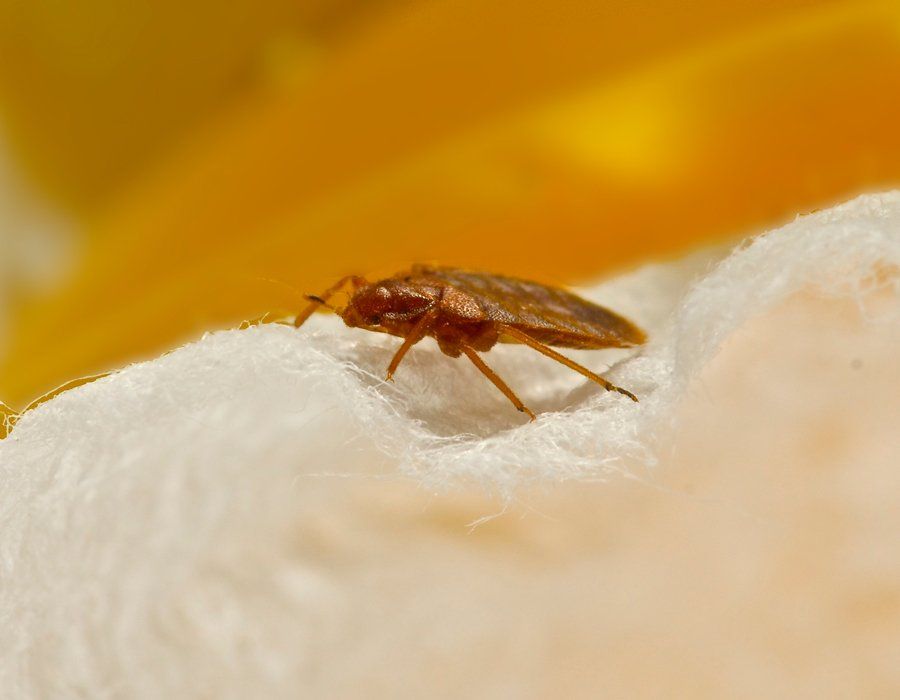Controlling Bed Bugs
Once the Bed Bugs Are Here
Bed Bugs are small wingless insects that feed solely upon the blood of warm-blooded animals. Bed bugs have evolved as nest parasites, and most have adapted well to living in people’s homes.
Hatching bed bugs are about the size of a poppy seed, and adults are about 1/4 of an inch in length. From above, they are oval in shape, but are flattened from top to bottom. Adults are a light tan to a deep reddish-brownish color. They are mainly found in furniture, mostly beds and box springs, but if disturbed while nesting, they will seek shelter in dark cracks and crevices.
Over the past few years, our knowledge about bed bugs has greatly increased, along with our success rate of eliminating them from our client’s homes. Bed bugs can be very disturbing insects when you have them in your home, and the longer you wait to address the problem, the more difficult it becomes to eliminate them.
We offer free bed bug inspections
to any customer who is unsure if they are having a problem with them, and our treatment prices and plans are without a doubt the most affordable around. Are you getting bit by something and aren’t sure how or what it is? Do you see blood spots or black residue on your mattress, box spring, or furniture? If so, call us and take the first step to eliminating these harmful and disturbing pests. We will make sure you sleep tight, without the bed bugs being there to bite.
We also offer protective covers for any size beds and box springs that are designed specifically for bed bug control. With these protective covers, bed bugs are not able to get in or on the mattress or box spring, as well as get out if they are already in there.
How Do Bed Bugs Invade A Home?
How do bed bugs invade a home? Because bed bugs readily hide in small crevices, they may accompany (as stowaways) luggage, furniture, clothing, pillows, boxes, and other such objects when these are moved between apartments, homes and hotels.
Used furniture, particularly bed frames and mattresses, are of greatest risk of harboring bed bugs and their eggs. Thus, one should scrutinize and consider the history of any used furniture, particularly ‘street’ items so plentiful at the beginning and end of each academic year. Because they readily survive for many months without feeding, bed bugs may already be present in apparently ‘vacant’ and ‘clean’ apartments.
Bed bugs can wander between adjoining apartments through voids in walls and holes though which wires and pipes pass. In a few cases, bats and/or birds may introduce and maintain bed bugs and their close relatives (bat bugs and bird bugs). Pest control personnel should be mindful of the presence of blood feeding insects and mites that may be left behind after removing nests or roosts of birds and bats in and on the home.
How Can You Tell If The Residence Is Infected?
Bed bugs infest only a small proportion of residences, but they should be suspected if residents complain of bites that occurred while sleeping. The bedroom and other sleeping areas should be carefully examined for bed bugs and signs of bed bug activity. Folds and creases in the bed linens, and seams and tufts of mattresses and box springs may harbor bed bugs or their eggs. They may also be found within pleats of curtains, beneath loose areas of wallpaper near the bed, in corners of desks and dressers, within spaces of wicker furniture, behind cove molding, and in laundry or other items on the floor or around the room.
Sometimes, characteristic dark brown or reddish fecal spots of bed bugs are apparent on the bed linens, mattress or walls near the bed. A peculiar coriander-like odor may be detected in some heavily infested residences. Adhesive-based traps used for sampling insects or rodents are not particularly effective for trapping bed bugs.
Bed Bug Checklist
The first thing you should do is spot check the bed. Peel back the bed sheets and check the mattress, running your fingers along the upper and lower seams. Make sure to check the mattress tag and plastic around the edges, bed bugs often hide there.
Check for tiny black spots behind the headboard, translucent skins or actual bedbugs. Bed bug spots (fecal matter) are dark brown to black in color and stick to the surface. If it falls off, then it’s not a bed bug spot. You can also take a wet towel and wipe the spot to see if it smears and if so, then it may be fecal matter.
Check the bedside table or any other furniture or fixtures near the bed. Bedbugs don’t like the light, so they’ll be hiding in areas that are usually dark or have very low light. Are there shed skins – as the bed bug develops, it sheds the skin which looks like the bug. Also look for tiny white eggs (like rice) along the edge of the mattress.
During the early stages of infestation (if you or someone just brought one home), the bug(s) usually hide out in the mattress (and headboard). If this is your home and you’re concerned you might have a few in the bed with you, it would be wise to buy a mattress cover; this will seal in the bed bugs and over time, they will die. We offer covers for all size mattresses and box springs.
Common areas for Bed Bugs to hide
Bed bugs love gaps in just about everything, so check:
- Behind baseboards
- Around door and window casings
- Around window sills and frames
- Behind electrical and telephone switch plates
- Between flooring and wall components
- Where materials meet to form a gap
- Around pipes
- Seams, creases, tufts, and folds of the mattress and box spring
- Bed frames and head board
- Under night stands and drawers
- Storage units
- Items such as furniture that may have hollow legs
- Between upholstered furniture
- Between the folds of drapery or curtains
- In your alarm clock
How to Prepare for Your Bed Bug Treatment
Verify
that your pest problem is a bedbug infestation. This will probably involve a visual inspection by an exterminator.
Prior to extermination, remove all bedding from mattresses; gather all linens, clothing, etc. from living space. This includes any textile materials that are machine washable - pillows, mattress covers, anything - and those that must be dry cleaned. Even fabric that is in storage should be collected. Wash bedding and any clothing/fabrics that may have come in contact with bedbugs in HOT water, and dry in the dryer if possible. Wash all other linens and fabrics as directed. After washing, place items in storage bins or bags, or garbage bags. Seal them up as much as possible to prevent bugs from entering and hiding in the clean fabrics.
Empty closets
in rooms where bugs have been found, or closets in which fabrics, linens, towels, etc. have been stored. The exterminator will need access into these spaces.
Unplug electronic
devices in rooms being exterminated. This will make the area more accessible to the exterminator.
Vacuum mattresses, box springs, floors, carpets, nooks and crannies. Steam clean, if possible, floors, rugs (if not machine washable), couch cushions, etc. Make sure to empty your vacuum outside of your home, whether it be bag or bag-less. You do not want to suck up any bed bugs or eggs and empty them into your interior garbage.
Move objects
away from perimeter of rooms. For example, if your sofa or bed is positioned against a wall, pull it away from the wall. The exterminator will need access to the perimeter of the rooms where bugs have been found, (probably bed rooms). Vacuum along the perimeter of the room, if you were unable to before.
Empty wooden bookshelves, desks, dressers, etc., and remove drawers if possible. Bedbugs can and will seek refuge between the boards of wooden furniture. This may include coffee tables, television stands, bed frames, photo frames, and box springs.
Make sure
to leave a contact number at which the exterminator can reach you, as you probably will not be allowed inside the space for about 4 hours. If you have infants or young children, you can expect to be out for about 24 hours.
Wait
for all mattresses, sofas, etc. to dry before sitting or lying on them. The chemicals used to exterminate the premises will irritate your skin.
By following these instructions, you are increasing the likely hood of getting rid of your Bed Bug infestation much quicker and with fewer visits. This will help you get back to your normal life before Bed Bugs invaded your home.










